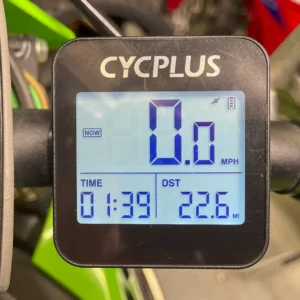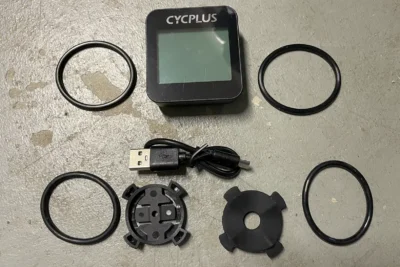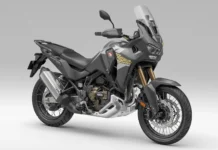We’ve been testing a lot of dirt bikes in the desert this year, taking advantage of the unusually cooler temps to enjoy riding in areas such as California City and Spangler Hills. With the many miles of wide-open terrain, it’s easy to lose track of time and miles, and we didn’t want to run out of gas on a bike such as the Kawasaki KX250X, which doesn’t even have a low-fuel light. Looking for an inexpensive way to track our mileage, we checked out the Cycplus G1 GPS wireless bike computer.
The Cycplus G1 is a basic unit that tracks miles traveled, minutes ridden, and current speed, in addition to displaying the time of day and altitude—that’s it.
Installation of the unit on an off-road motorcycle is equally basic. Fit the supplied Garmin-style quarter-turn bicycle mount and its vibration-reducing rubber insert onto the handlebar and secure with a pair of rubber bands (two lengths are included). Make sure one of the two notches in the mount is at the 12 o’clock position. That way, when you attach the G1 and give it a quarter turn to the right to lock in, it will be facing upright. Note that it is much easier to install the mount on the handlebar with the G1 detached.
The Cycplus G1 is secure with this simple mount—we’ve bounced at high-speed over many miles of rough terrain on various bikes without it shifting. If you want to glance at the data while riding, it is a bit hard to read, especially if you are standing on the footpegs while roaring across the desert floor. Of course, this is exactly when I look down, trying to see how fast I am going for bragging rights later.
With a back-lit two-inch LCD, the Cycplus G1 is a small device, measuring just over two inches square, 1.5 inches thick, and weighing in at 2.5 ounces, including the mount and rubber bands. The display is further divided into three fields of data—one large field that utilizes almost two-thirds of the upper screen, and two side-by-side fields that share the lower third of the screen. Additionally, there are three windows that you can cycle through, all with the same layout.
No matter which window you are looking at, your current speed occupies the large field. As you cycle through the three windows, you can see the following pairs of data: TOT (total ride time) plus ODO (odometer); TIME (elapsed time) plus DST (current distance); or RTM (local time, oddly) plus ALT (altitude).
Getting your G1 configured takes a bit of patience. However, once you’ve set your preferences (imperial vs. metric; time zone), you won’t have to fool with it again. There are only two buttons on the G1—Power and Settings. Part of the patience is due to poor labeling in the Settings pages and Cycplus using the same menu layout from its higher-end bicycle computers and simply eliminating the pages irrelevant to the G1. When you move through Settings, the first page is C4, then it jumps to C6, C7 (factory reset), and C8.
Making selections is a sequence of short presses on the Power and Settings rubber buttons (which have a nice feel) to select, change, and confirm selections. Setting the proper time zone takes a quick online search to find your zone relative to GMT. In SoCal, we are -8 hours (-7 during Daylight Saving Time), so that takes a lot of button pushing to cycle around the world clock as there’s no backward scrolling. Once you’ve set your configurations, a long press on the Settings button takes you back to the main screen.
At any time, you can short press the Power button to switch the Speed display from Current to Average or Max speed. So, when taking a break, I can check what those numbers are. The LCD screen is crisp, and the high contrast aids in reading data on the small screen.
The G1 has a 600mAh rechargeable battery with a claimed 20 hours of use from a full charge. Our dirt bike rides are far from Iron Man length, so we don’t plug it in after every ride. When it needs juice, we simply plug in the included Micro USB charging cable for a couple of hours to get back to full charge. The charge port is on the bottom of the unit and well-protected from the elements with a thick rubber gasket.
This brings us to the G1’s durability in the elements. While we’ve gotten lucky this winter to splash through a lot of water on trails post-rainstorms, it never bothered the Cycplus G1, which has an IPX6 rating for water and dust intrusion resistance. We don’t usually remove the G1 when pressure washing a mud-splattered bike, though we avoid direct assaults on the unit.
While the Cycplus G1 GPS wireless bike computer may be lacking some convenience features—a battery charge indicator, a way to save rides, an easier configuration menu—it is a budget-friendly option for keeping track of essential info that will keep you on the right side of an empty tank, and let you know if you hit a higher speed than your friends.
Cycplus G1 Price: $36 MSRP

















![2024 Suzuki V-Strom 800 Touring First Look [Fast Facts + Photos] 2024 Suzuki V-Strom 800 Touring First Look: MSRP](https://ultimatemotorcycling.com/wp-content/uploads/2023/10/2024-suzuki-v-strom-800-touring-first-look-3-218x150.webp)
![2023 Motocross of Nations Results, Video [France Dominates] 2023 Motocross Of Nations Results](https://ultimatemotorcycling.com/wp-content/uploads/2023/10/2023-motocross-of-nations-start-218x150.jpg)

